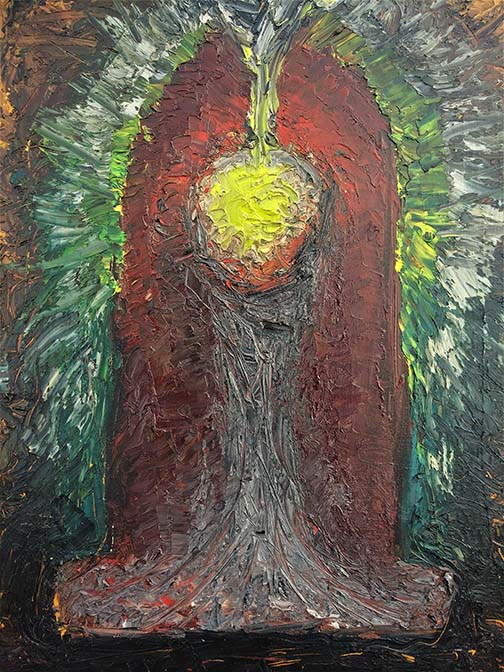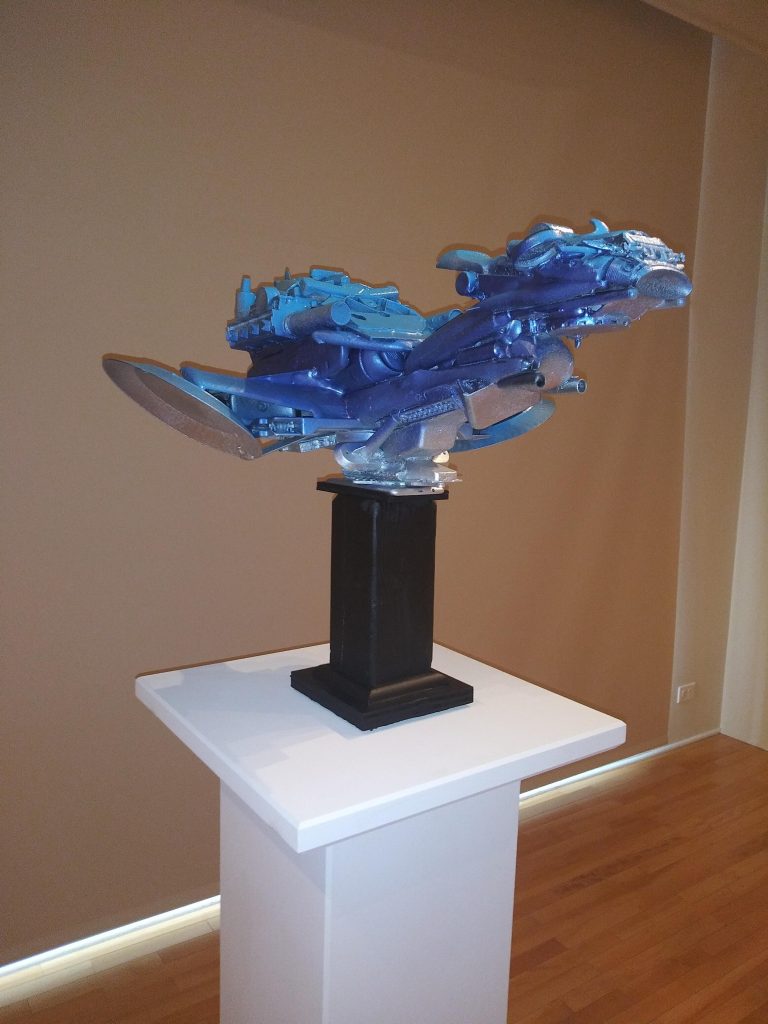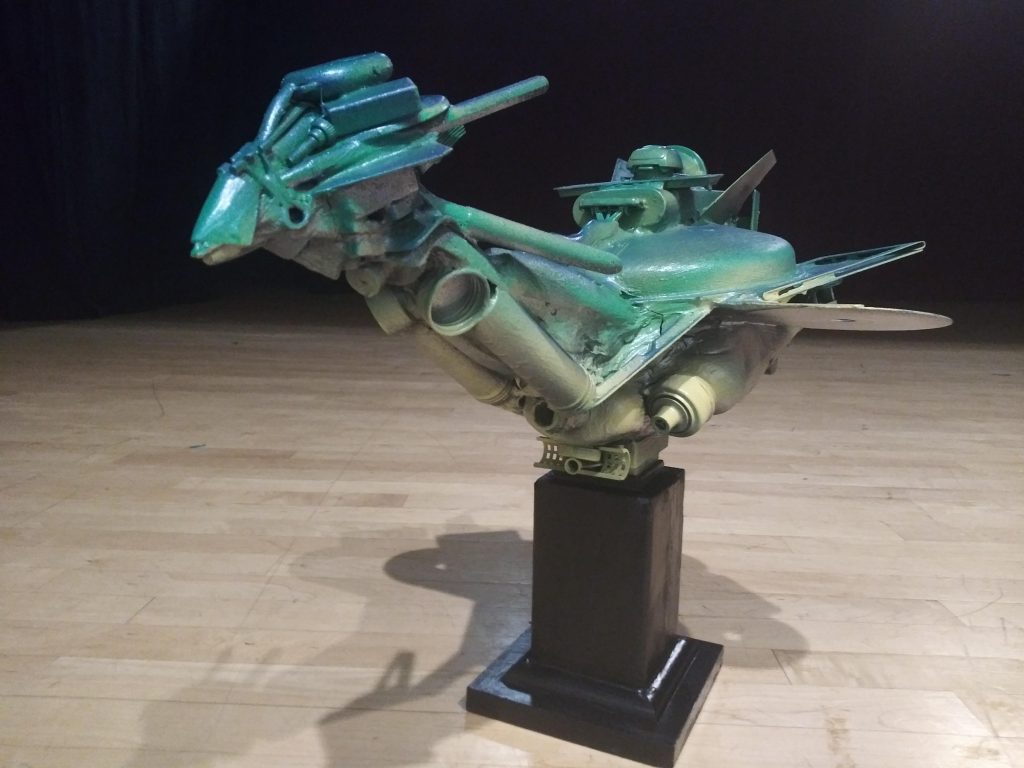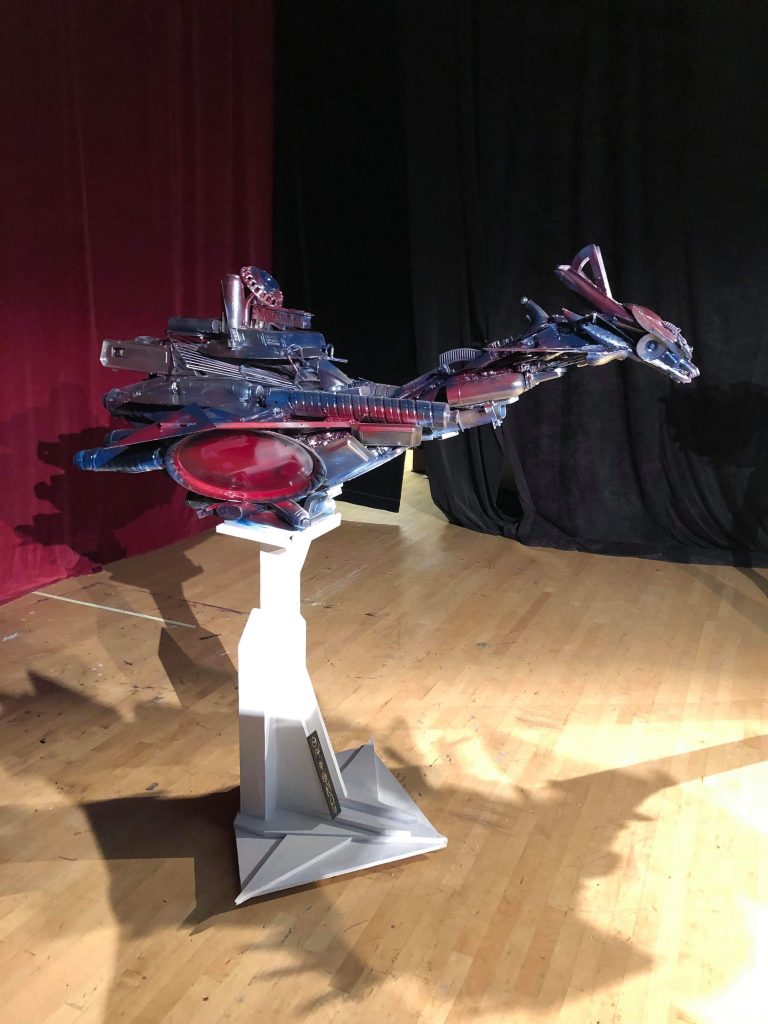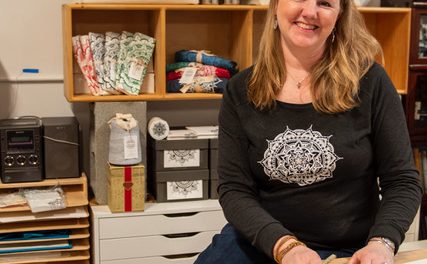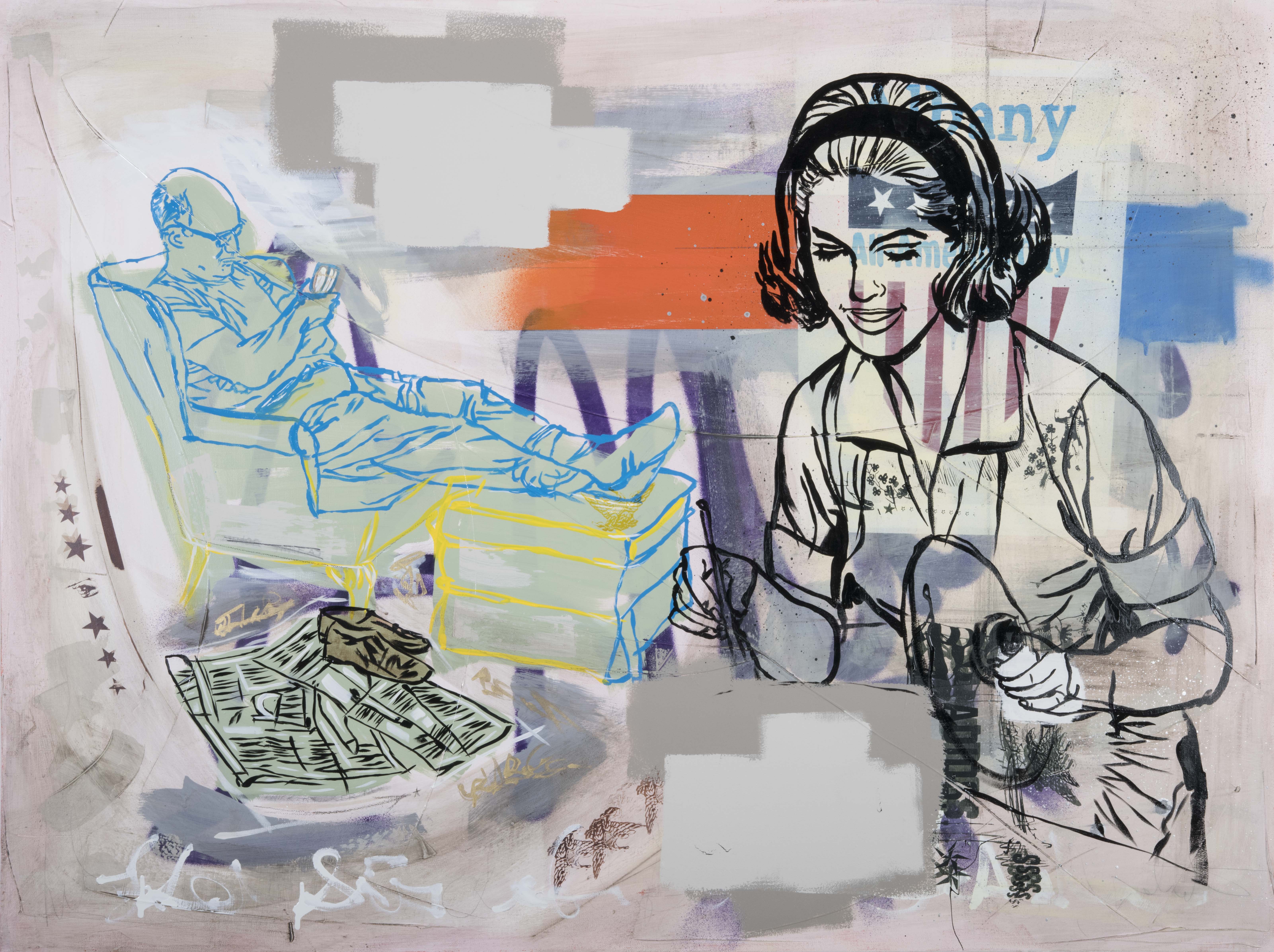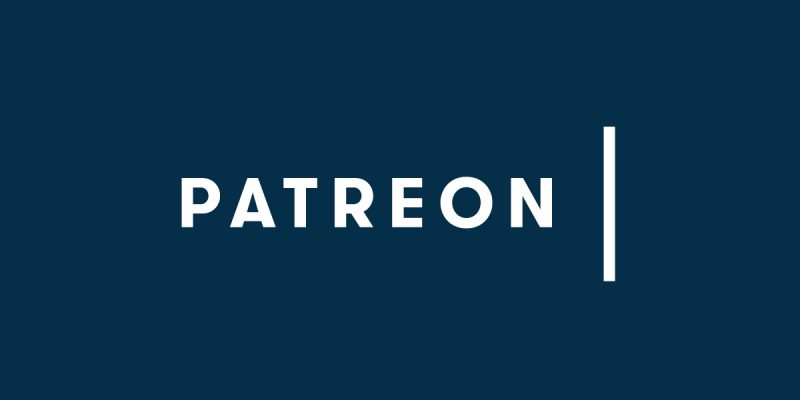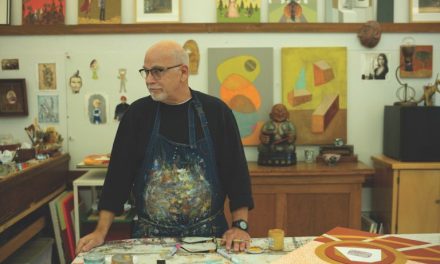Painter, sculptor, healer
Current hometown: Albany
Age: 57
Current project: Completing work on a show premiering in March at the Albany Barn, where he has a studio; working on a new series of paintings; continuing to build spaceships
Collaborative Media’s Maker of the Week is made possible by KeyBank.
In addition to his full-time career as a licensed clinical social worker, Royal Guy Brown Jr. has found myriad ways to explore connections between abstract art and the spiritual realm. One of his upcoming projects is a series of paintings based on the Seven African Powers, a term for some of the most powerful Orishas, or guiding spirits, in the Yoruba shamanic tradition of Ifa — a tradition in which Brown is a Babalowo, or high priest. He also builds dragon-like spaceship sculptures out of household junk, using them to represent an otherworldly consciousness with able to transcend humanity’s narrow perspective. He has five currently under construction. “The spaceships are an addiction,” he says. “I can’t stop making them.”
Let’s talk about who you are as an artist.
Things have congealed over the past couple years. I had a show at the Barn called Messengers & Messages. That show basically consisted of the spaceships I make out of junk, which I name after angels.
I started to think about “What would these beings be saying to humanity?”… I decided to use an alphabet called the Keys… I just finished doing a series of 16 oil paintings that are of these Keys. I am now finishing up a book that explains how they’re used phonetically, and also how they’re used from a spiritual perspective — as like a spiritual alphabet, or an esoteric type of an alphabet.
So each one of the paintings represents a Key, which is associated with a letter in the alphabet?
Yes. There’s 16 of them. One of them would be like the Gate… it represents transition. If it was a tarot card, it would represent transition from one thing, like life or death, birth… anything that has to do with a real human transition.
It also represents three letters — D, T and N… if you look at how your mouth is placed when you say (them), the only difference between those three letters is a hard sound, a softer sound and then a vocalized sound. That’s how all of the Keys break down into sort of a phonetic alphabet.
Each of the keys represents multiple letters, multiple sounds?
They can. The vowel sounds are singular… it depends on the letter. It’s not a static system where I was like, “OK, each one of these will represent two letters,” or something like that. It has to do with how the letter is vocalized. Like a V and an F — V is vocalized, and F is just blowing air. But your lips and your teeth are in the same exact position for both… it’s sort of a phonetic breakdown of the sounds that the letters make that determines how they’re used.
These represent the messages being sent?
I had four panels, and each of those four panels were where the messages were written in that language… there were haiku poems that I had for each ship, as well as the four panels with longer messages. People who came were given a booklet where they could decipher all of the messages from the Keys into human language.
That is totally wild… you invented the language?
Yeah (laughs). It’s kind of my thing… (the Keys) started to kind of come to me, honestly, when I was in high school. And I’ve just been playing around with them and playing around with them and designing them. They’ve just been with me for a very long time, and it was only like last year that I felt that they were in a place where I could actually utilize them… they just kind of solidified. They became something that was really coherent… like, “Wait a minute, I can decipher this.” I can take this, and I can write it down, and I can use these symbols. And then another person can get the Key, and actually read it.
It was funny (at the show), because… everybody was running around, just having a great time deciphering these things. It was the deciphering that was the fun of it.
What’s an example of one of the messages that you could have translated?
I’ll put it this way: If there are messages to humanity, they usually have to do with how human beings kind of need to get their stuff straight, or they’re not going to be around for very long.
It’s not so much the threat that these ships are going to come down and just take humanity out… this is where it starts to cross over into the spiritual, because the idea is that the spiritual world and the world of intra-dimensional beings is so much faster and larger and bigger. And we’re sitting here on this planet, fighting each other over the dumbest things. From that perspective — if you’re actually looking down on the planet from an angelic perspective… you’re scratching your head saying, “What is your problem, humanity?”
We’re destroying the planet itself, and it’s like, “Wait a minute. This is a living thing. Don’t you get that the whole COVID virus is really the Earth’s antibody against you? I mean, when are you gonna figure out that you’re the problem here? And you’ve got to come together, or else you will destroy yourselves.” That’s kind of the message… that’s kind of the gist of most of them.
You said the spaceships aren’t going to destroy us. I was looking at some of the photos, and sometimes you mention “weapons” that they have on board.
Well, they’re badasses, I’ll admit it… When I say they’re named after angels, these are like Old Testament angels. They’ve got weapons, they can do some damage if they want to.
So some wrath of God type stuff.
Yeah, they could do some wrath of God type stuff, absolutely.
I’m fascinated by what you just said about COVID. That’s like a whole other way of looking at it — it’s like the planet trying to rid itself of the disease of humanity… the Earth, as a living thing, is trying to right itself by bringing something like COVID along.
Right… a lot of people are into the Law of Attraction and all that kind of stuff. It’s like, that’s absolutely real, but people miss the point. It’s not like a get-rich-quick scheme. It’s not a way of finding the perfect mate. The Law of Attraction is just the law that’s always there, which means that what we collectively think manifests.
It’s really interesting when you think about how we’ve been all about separation by race, by country, individually — we’re always separating each other, you know? All the way down to the family unit. Everything’s gotta be separate. And what does this COVID thing force everybody to do? Separate.
We’ve created our own curse by putting so much emphasis in our own souls and in our own thinking on how we’re separate from everybody… we’ve created separation from everybody, and now we’re like, “Oh, this is so terrible, how did this happen?” Well, wake up.
Shifting gears here, you build the spaceships out of junk. What kind of junk are we talking about? What kind of materials are you using?
Well, I have one here that I started… I have an empty bottle of SuperWeld Super Glue, I have two bottles of medicine and I have a bottle of Downy, a small bottle of Downy fabric softener. That’s what this one is being made out of, so far.
If you’re sitting and looking at (the spaceships), if you look closely, you can recognize just about everything… things you’d have lying around the house, or things that you threw away yesterday.
So you’re just gathering items, and finding uses for them in your art?
Absolutely. Sometimes I go looking for stuff… you know those little airport bottles of liquor? I don’t drink… I’m not going out and purchasing them. But if I see them on the street, I’ll pick them up in a heartbeat if they’re empty. They just make great parts. And there are certain things like razors, pens, things like that; I will go and I’ll actually buy them… I do purchase things purposefully. But a lot of it is just stuff that, instead of throwing them in my garbage, I put them in a bag, I bring them here to my studio and I’m using them here.
I have a lot of things like paper plates; I have a lot of old CDs, and those I use specifically for lift discs… that’s a technology that was actually played with by scientists as an anti-gravity mechanism… I just recently went to the supermarket and I bought plastic Chinet plates to be lift discs.
So you choose what feels like it fits.
Yeah, it fits what they’re doing… (and) everything I make is in scale with each other. So I have little ones that might be an inch long, and big ones that are about 60 inches long, but there’s a scale. There’s HO scale with model trains, and there’s a scale smaller that’s called N scale. And I actually have a jar of little N-scale people that I purchased, just so I could keep the scale in mind. Everything that I build is within the N scale, so I’m very specific about what I’m buying and what I’m picking up or what I’m throwing out… when I’m building them, it’s like, “Will a person be able to go from point A to point B? How many people would it hold? Would it be someone that could fit in this cockpit?”
All those kinds of things go into it. I’m really kind of weird. (laughs)
You said you started thinking about this in high school. How did you get started actually doing this? Do you have any training as an artist, or are you more self-taught?
I am more self-taught. I started making spaceships out of, literally, boredom. I was into model airplanes, and I had so built so many that I could build them without using the instructions. They ceased to be a challenge for me.
Right around that time, “Star Wars” came out, and I was really frustrated with “Star Wars” toys… none of them were in scale with each other. You could buy a Millennium Falcon and then you could buy a TIE Fighter, and they were all about the same size — but they had nothing to do with how many people would fit inside them. There was no scale to them, and that kind of pissed me off for some reason. I don’t know why, but It just did!
I was just like, “Well, you know something? I’ll make my own spaceships. And I’ll keep them in scale with each other.” And I started kitbashing*, and it sort of evolved since then. (*Editor’s note: The term “kitbashing” refers to the practice of taking pieces from commercial model kits and combining them into something new and original.)
I do have a bachelor’s in fine arts, and I learned a lot of painting and things like that, which is another whole part of what I do. But when I was doing sculpture, and I was working in the sculpture studio… that’s when I think that the designs became more sophisticated.
I stopped looking at them as just toys… I started trying to look at them as something that could be beautiful, even though it’s this weird sort of abstract thing.
Say more about what you’re doing with painting.
When I was engaged in the Ifa tradition… and I was starting to work with the ancestors, I was doing some painting. I was in school at the time, I was actually in art school at SUNY, and I started to notice, like, faces coming through these abstracts. I was trying to do abstracts, but faces kept coming through… I actually got to a point where I was doing these ancestral renderings, and I was doing them for other people, and I was doing readings for them as I was doing them. I found that this is where the art and spirituality started to mix together.
So you’re saying that you were going for abstract, but these faces just started appearing without your intending them to.
Oh, absolutely. I gave up… I said, “OK, fine, you guys want to come, I’ll start doing it.” I just gave up. I stopped fighting. (laughs)
And you offered that as spiritual readings for people?
Yeah, for a while. I was living in Troy. There was this place there, just a little shop; when they did the Victorian Stroll, I kind of set up a place… I would do it in pastel, and I’d have 18”x24” paper. People would sit down in front of me, and I would start — I would just do whatever happened. And images of faces would come through… it was like a dialogue would happen, where it seemed like messages or something were coming through when I was doing it.
It got to a point where… some of the things that came through were a little bit frightening. It got to a point where I kind of stopped doing it for a while, but for a little bit it was very interesting. What stopped me in my tracks was, at one point when I was in my apartment… this weird laughter came through, and to make a long story short it was like the being that I was sort of painting, if you will, ended up being like a Nazi… and the message that came through was like — I remember it so vividly — he said, “You know, we won that war.” And I was like, “Wait a minute, Germany didn’t win the war. What are you talking about?” And the message was, “As soon as the United States dropped the atomic bomb, it was the end of compassion, which is what we were going for in the first place.”
I stopped doing it after that.
You were actually literally hearing the voice?
I don’t know how to describe it… it’s like spiritual passages. I’ve been involved in mentoring training; I’ve been involved in the Ifa tradition. All of these things have to do with direct communication with Spirit. So you hear it, or feel it, or sense it in lots of different ways.
Tell me more about the Ifa tradition.
It’s a shamanic tradition, very closely tied to other Earth-centered traditions, like Native American shamanism, or even Wicca; that is like European shamanism, if you will. It came to this country through the slave trade, and it became different things that might be more familiar to people… in South America, you’d have things like Candomblé; in Puerto Rico, you’d have things like Santería… filtered through the French culture, it became more like Voodoo in New Orleans. But the core part is Ifa. That’s the basis of it.
A lot of the other traditions are just as powerful; I’m not trying to take anything away from them. They just got filtered through different cultures.
So that’s the thread running through these other traditions.
Yeah. That would have been, and it continues to be, the indigenous Nigerian tradition of the Yoruba people. But as we were taken from there and brought in the slave ships, it survived through Christianization… if it was the Spanish, they would have an attitude of, “Well, as long as we see pictures of the saints, you can do what you want.” So you’d see, like, full-blown African ritual, but you’d see pictures of Saint Barbara or Saint This or Saint That. And behind that picture of Saint Barbara would be the deity Shango, that would actually be worshipped or brought down or communed with by the people who were brought over here.
There are still things like… when you have the gospel and people dance and they’re “taken in spirit”… people don’t know it, but that’s like pure Ifa. (It’s) the idea of drumming and dancing, and through the process you go into a trance-possessive state where the Orishas come into your body and they speak through you. That’s speaking in tongues; they’re not the only ones to do it, but especially if you’re dealing with more of a Black church, if you will, that’s a direct line to Ifa. I think that. Most Christians would probably hate me for saying it. (laughs)
That’s too bad. You’ve got the microphone right now. Were these deities some of the faces that were coming through your paintings?
When I was learning about them, I definitely painted them, as a way for me to get in touch with them. It wasn’t so much that they were coming through me, and then I noticed; I was reaching out to them to say, “Teach me about you.”
There’s (the) ancestors, there’s Orisha, there’s the interstellar beings if you will, or angels. They’re all coming through… it’s like the one thing that threads through all my work, even though it’s hard to look at spaceships and a picture of an African mask and say that they’re related. They’re all my one expression.
You have another name that you use, Omitola Brown.
That’s one of the initiated names that I received through the Ifa tradition. There’s another one, Ifarinmoade; that is when I became a Babalawo, or like a high priest… You’re initiated as a priest of a specific Orisha, and then you’re a Babalawo, which is the diviner.
Every human being coming to this planet… came here with a certain destiny. And destiny isn’t really like, “This is going to happen to you, no matter what.” It’s not a fixed destiny; it’s more like, “This is your greatest potential. This is what’s going to bring you the most happiness, and this is what’s going to bring you the most success, if you follow this path.” The idea of the Babalawo is that when you’re born, you forget all of that — that deal that you made with the Creator to do this or that. The job of the diviner is to help you remember what that was.
You know, you gave me a whole other perspective on how you see the pandemic. I usually ask everybody, “How did the pandemic impact you as an artist?” I don’t know if you’d have an answer to that.
I would like to think that… maybe people could be a little more open to the art that I do. I think that with the pandemic, and also with Black Lives Matter, it’s this different thing because my message isn’t specific to those things… I feel like what my art is about (goes) more to the core of what’s wrong. I’m trying to deal with the disease, where all these other things are the symptoms. So in that sense, I’m hopeful that maybe people have gotten so fed up with the symptoms, that maybe they might be open to looking at the disease. But that’s a tough one, because the disease is in all of us. We are the disease.
It’s like being in recovery; I’m also an addict in recovery, so it’s like that process. You have to kind of look at yourself really hard, and really honestly. And really say, “This is what I did.” Forget about what everyone did to me. This is what I did, and this is the kind of stuff I have to work on. And that’s a tough sell! I mean, as a therapist, that’s a tough sell for people. It’s very seldom that you’ll find people that want to enter into a healing process where they’re like, “How do I fix me?” So much of the time, it’s like, “How do I fix the other person?… How do I get this person out of my life?” They get the person out of their life, but they don’t fix themselves, and then they invite in the same person. Different face, different name, but the same person, right? The same crap comes back. That’s the hard part. I would like to think that (because of) the pandemic and everything that’s been happening, maybe people can be a little bit more open to what (the art) is about. But I’m not sure yet.
I think that at this point, I try to go back to the idea that it’s like, you know, you come in, and you can decipher these messages. And whether you believe or whatever in the messages themselves, at least you can have fun deciphering them. You can have fun looking at the work, because the spaceships themselves… you can say, “Oh jeez, that’s a fork. Wow, that’s a bottle of deodorant. Oh my god, that’s like orange juice!” Seeing those things at a different level, which is much more playful. But maybe if they get hooked with the playful part, maybe some of the deeper things that I think are going on right now… all these things, I think, are just a part of us seeing this dark underbelly that’s always been there. And we have this opportunity of pretending that it’s someone else — or understanding that this is just a part of everything that we have to really look at and try to heal.
And you’re saying that you would see your art as speaking directly to that: the challenge of healing the disease within.
Right. And I guess like, pointing to it. Like saying, “This is what it is.”
If you could look at the planet Earth from space, and take that point of view, looking at it from that perspective, what would you honestly think? Would you really be able to say that the Bible is the end-all, be-all? Would you really be able to say that “I’m a proud American,” or “I’m a proud Russian”? Or “I’m a proud Nigerian?”… when you look at the planet and it’s like, “Wait a minute, there’s no lines there. There’s no lines from space.”
In outer space, it doesn’t matter that you’re an American.
It’s bullshit! It doesn’t exist. The whole thing is a creation; it is our own human creation. There’s no actual, factual anything to it, period, because this planet does not have lines drawn on it.
Yeah, we just made all that up.
Exactly! And it’s like, “Well, guess what? If you made it up, you can change it.”
Find Royal Guy Brown Jr. online: Website, Facebook, Instagram
Wish to nominate a Maker of the Week? Email nominations.



